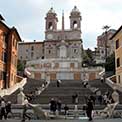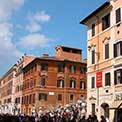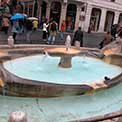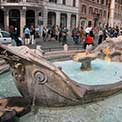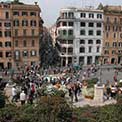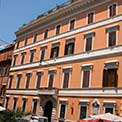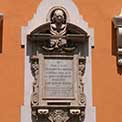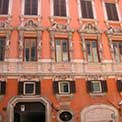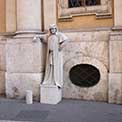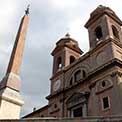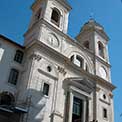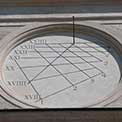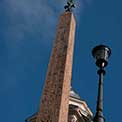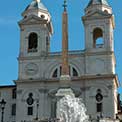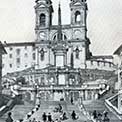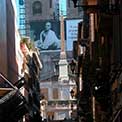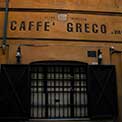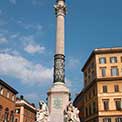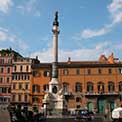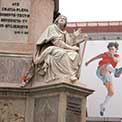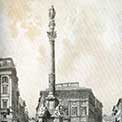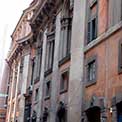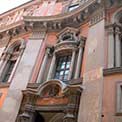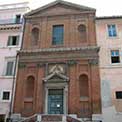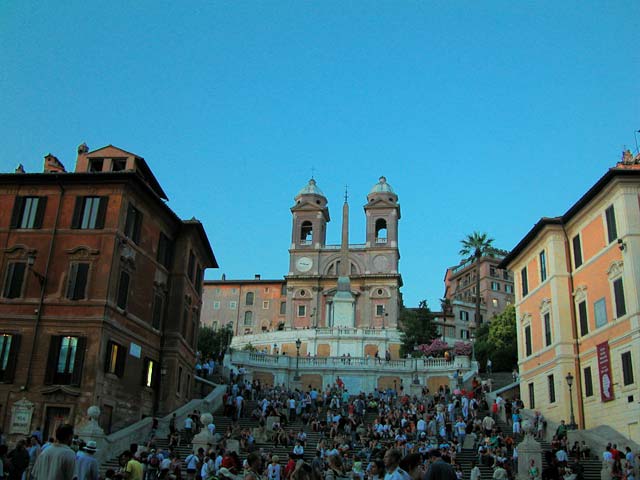
At Rome, strangers who live in private lodgings, generally have dinners sent home to them from a Trattoria, in the Piazza di Spagna. The dishes are all conveyed in a large basket, lined with tin, with a little stove or iron heater inside ; so that they are quite hot, and v.ery good—but certainly not cheap, for they cost ten pauls, or about five shillings a head, without wine, bread, or desert.
Some English families, whose lodgings had the rare appendage of a kitchen, tried the plan of having dinner dressed at home, but their cooks cheated them so unmercifully that they were nearly ruined ; they then made a contract with them, and were nearly starved.
But English habits and accommodations must necessarily spread rapidly throughout Italy, with the unceasing torrent of English travellers and English wealth which pours into it. The influx of strangers, indeed, into this country is astonishing, but they are all from the north of Europe. No Spaniards or Portuguese, and very few French, are to be seen. But Germans, Swedes, Poles, Russians, and more especially English, descend from the Alps in such numbers, that Rome seems in danger of another invasion from 'the Goths. Americans too—men from a world unknown to the Romans—may be seen gazing at the ruined monuments of their power and grandeur.
" Qnse tarn seposita est, quae gens tarn barbara, Caesar,
Ex qua Spectator non sit in urbe tna?"*
There is one table d'hote kept by Frantz, a Germau, at the Scudo di Francia, where there is a dinner every day both at two and five, and where the fare is said to be as plentiful, and the price as cheap, as in France. But it is the German, not the French Cuisine. It is chiefly frequented by young foreign artists and students.
The Egyptian obelisk, now at the Trinita de Monti, which, was found here, could not have been erected by Sallust, because he died before the conquest of Egypt. It must have been placed here by Augustus, or some of the later Csesars.
The ruins of the house of Sallust still stand by the side of his Circus. You may ascend by a weed-covered staircase to the second story, where, not many years ago, we were told some few vestiges of ancient painting were to be seen, and where, even when I first visited it, several patches of mosaic flooring still remained. But the last time I was there, every trace of them had disappeared—carried off, as the countryman who shows the place informed us, by the Forestieri.
Rome, in the nineteenth century: containing a complete account of ..., Volume 2
Di Charlotte Anne Eaton - 1827
Church of SS. Trinità dei Monti
the church and religious house of the Trinita di Monti, which belongs to the Sisters of the Sacred Heart. The church erected by Charles VIII. of France belonged to the Minims, and after various changes it has at length come to tho Sisters of the Sacred Heart who impart to tho young Romans a good and Catholic education, both by the means of poor schools and of tho boarders which are received in the convent. The church itself contains some beautiful frescoes. Amongst these is the famous Descent from the Cross by Voltcrra, said to bo tho third finest painting in the world. The group of the Blessed Virgin, of the Holy Women, and of the Dead Christ, are most striking. The cloister is painted in frescoes, containing Homo events taken from the life of tho founder of the Minims. The gardens are beautifully laid out, and extend along the side of tho hill. Too much cannot be said with respect to tho real good which thoso holy women are doing for the cause of education, in the holy city. Their novitiate is at the Villa Lanto, on the Janiculum. Opposite tho church is an obelisk, which Pius VI. had transported here in 1789, from near St. John Lateran. It is of Egyptian granite, 48 feet high without the pedestal. It formerly stood in the circus, in the gardens of Sallust.
Rome: its churches, its charities, and its schools
Di William H. Neligan - 1858
Church of the Trinity
This church was built in 1741, from the designs of Emanuel Rodriguez, a Portuguese: it is of an oval form, and adorned with gilt stuccos and pictures, by Francis Preziado, Casali, Gaetano Lapis, arid Conrad Giaquinto, who painted the great altar-piece. The martyrdom of St. Agnes, in the last chapel, is by Benefiale.
A new picture of Rome and its environs in the form of an itinerary
Di Mariano Vasi
Colonna dell'Immacolata
The definition of the Immaculate Conception
I All Home is en ftto to-day ; it is tho day which has been so long looked forward to; the Immaculate Conception is to be defined; it is to-day as it was at Ephcsus ccuturios ago. Tho Romans aro prepared to welcome the definition of tho Immaculate Concep • tion, as tho Ephcsians wore that of tho maternity of tho divino mother, with sougs of gladness, illuminations, and all the possible demonstrations of their joy. Cardinals and Bishops havo assembled from all quarters of the globe, in obedience to tho summons of tho Holy Father, to aid him by their deliberations as to the manner and form in which tho dogma is to bo defined. Days havo been spent, under tho guidance of throo of the most learned of tho Cardinals, assisted by the most eminent theologians of tho Eternal City, in framing the docrce by which tho Holy Father is to make known his definition to the Christian world. That basilica, where Bo many wondrous events connected with tho history of mankind havo taken place, is to be the scene of this mighty deed. Before tho tomb of tho Apostles the Holy Father is to pronounco that decree, which will go forth to all quarters of the universe. There has been much rain in Rome during the past week; but the morning boa shone forth with all the brightness of an autumnal day, and the sky, which for the last week has been obscured by clouds, to-day puts on its brightest blue. Two hundred bishops and cardinals have assembled in the Sistino chapel, and there await the Holy Father. They have put on their vestments and form a noble spectacle. At the appointed time the procession is formed, and moves down the scala rcyia, those beautifully formed steps which load from the Sistino chapel and the sola regia to the piazza and St. Peter's. The litanies are intoned by the Pope's choir, and the forty thousand persons that have assembled within the walls of the basilica hear the song of intercession, as it draws near and nearer, with the deepest anxiety and emotion. At length the head of the procession enters the basilica, and goes onward through the assembled people, a way being kept clear by the soldiers. The Holy Father, carried in the sales gestatoria, makes his appearance; all kneel to receive his benediction. The song of prayer has ceased; for all are kneeling in humble adoration before the altar of the blessed sacrament. The procession begins to move again, and enters the choir of the church, which is prepared for the occasion, in the usual manner. The Holy Father takes his scat on the throne, at the side of the choir. The office of Tierce is commenced, and the Holy Father puts on his vestments, (those who are to partake in the solemnities of the day do the same,) the tiara is laid aside, and ho assumes tho golden-colored mitre. At length tho solemnities of the mass begin. Tho deacons and sub-deacons, preceded by tho cross and seven candles, move onward. Lost of all comes the Holy Father, between tho two cardinal deacons, who are tho assistant deacons of tho throne. He uses no crosier, in accordance with the ancient tradition of St. Peter's sending his crosier to have it placed on the body of Martial, who had died on his way to preach the gospel in Germany, in order that ho might be raised from the dead, and might proceed on his mission. On the way, the Holy Father stops to embrace the throe junior cardinal priests; arrived at tho steps of the altar, ho lays aside his mitre and begins tho mass, •with the deacon, tho sub-deacon, and tho assistant-priest, who is a cardinal; the altar is incensed; he embraces the assistant-deacons, and goes in procession to the throne, which is erected in tho centre of tho choir, boforo tho chair of St. Peter. Tho Kyrie is sung, and tho Gloria is intoned by the Holy Father iu a manner which, makes all who hear him think that the Apostle still speaks through his 458th successor. Tho Epistle and Gospel arc sung first in Latin, then in Greek by two students of the Greek college. Tho Greek deacon and suh/deacon were arrayed in the vestments which the Greek rite prescribes. This custom was followed formerly in other churches, to show tho unity between the eastern and western churches. Now the solemn moment arrives, when Peter is about to speak. The dean of tho College of Cardinals, Cardinal Macchi, an aged confessor of the church, laden with years, and with merits •which ho has gained in tho service of the church, advances before tho pontifical throne, accompanied by a Greek and an Arminian bishop. In the name of Christendom they address a final petition to tho Supremo Pontiff, and ask him to promulgate the definition of tho Immaculate Conception. The Holy Father seems still to hesitate. Years have been spent in considering tho matter. The Supreme Pontiffs in different centuries have issued their decrees respecting it. Theologians have •written on it. Within the last few years, tho bishops of the church have besought tho Holy Father, entreating him to hasten the definition. Within the last month the assembled prelates have deliberated respecting the form of the decree, but it seems that something yet remains to bo done. Prayers bare been made to heaven for grace and light to goide the
\ Holy Father in this matter, but more prayers are yet to bo offered. All fall on tkcir knees, cardinals, bishops, priests, monks, friars; and thousands of people, from all quarters of the universe, are prostrate to ask for more light and grace from the Author and Giver of all good tilings. The Holy Father intones the Vcni Creator, which is responded to by the Yoices of more than forty thousand people who have now assembled within the vast nave and transepts of the church. Once again all is hushed, and the pontiff stands erect on tho chair of Peter, and, with a voice indicating tho deepest emotion and broken with sobs, and in the midst of a torrent of tears of joy, he pronounces the solemn words which place the Immaculate Conception of tho Blessed Virgin among tho articles of faith. -Never shall I forget that moment; it seemed as if the things of earth had passed away, and the heavens had come down to bless us. Near me stood a poor Franciscan friar. Tho tears of joy rolled down his checks, his utterance failed him, for now tho long-expected moment for which his order wrote and prayed through so many centuries seemed to have arrived. Tho emotion of tho Holy Father had spread itself around, and but one prayer seemed to burst from tho heart of all: " Now dost thou dismiss thy servant, 0 Lord, according to thy word in peace." Tho castle of St. Angclo sends forth its thunder, tho bells of tho Vatican send forth their merry peaL From the tower to the bell-turret the echo is beard, and tho sound responded to, and the fact tho most wondrous in the annals of nineteen centuries, tho promulgation of tho Immaculate Conception, is mode known to the Eternal City. " The heavens rejoice, tho earth is glad, tho sea is moved and tho fulness thereof, tho fields and all things that are therein are joyful;" for a new ray of glory is added to the crown of the Mother of Ood.
Again all is hushed, and the Holy Father intones tho Creed, which is sung in the solemn manner that the choir of the Papal chapel always makes use of. The Holy Father once more proceeds to the altar to consummate the definition, which he has now uttered, by offering the holy sacrifice for the flock of Christ committed to his keeping. No person that has ever witnessed tho solemn moment of the consecration in tho Pope's high mass, can ever forgot it Midway in the dome are placed trumpeters, who play on trumpets whoso notes are indeed silver-toned, that wondrous music which for years afterwards will be ringing in the cars of those who have heard it All assumes the stillness of death, and every one is bowed in prayer, as the Holy Father elevates tho host and tho chalice to the four quarters of the heaven. You hear the clang of armor as tho noblo guard rise from their knees, and the mass proceeds, the choir singing some of their heavenly strains. Once more tho Holy Father returns to hia throne, and there stands wrapt in profound contemplation, as the deacon and sub-deacon bring him tho elements, that ho may consume them. This rite of the papal high-mass is most solemn. Tho Holy Father's receiving tho chalico through the tube carries you back to tho ages long since gone by. Onco more ho returns to tho altar, and the mass is concluded as on other occasions, except that before it ends the To JJcum la sung in thanks for the wondrous work of God, which all have witnessed in being permitted to hoar tho definition of a dogma which all Christianity has so long looked forward to with an anxious eye. Forty thousand voices join in sending on high tho song of praise and thanksgiving, for these are Romans, all of whom have been taught from their earliest days to sing tho songs of praise and adoration, and can therefore readily joiu.iu tho worship of tho Most High ; but still tho honors done to tho Mother of God are not finished, for an exquisite mosaic of the Immaculate Conception in the chapel of the choir is to be crowned. The procession once more is formed, and the Holy Father, surrounded by Cardinals and Bishops, proceeds to finish the work which has been allotted to him by the providence of God. This being accomplished, he returns to the chapel, where he usually unvests, and receives the congratulation of the assembled prelates, whom to-morrow he will honor with a medal struck in honor of the occasion, and an address in the private conaistory.
But Borne has not finished her rejoicings. The cupola of St. Peter's is to be illuminated, and the entire city is proparing to honor the Queen of Heaven. Every madonna at the corner of the streets, and in the front of the houses, has its illumination and its wreath of flowers around it, and every window is filled with lights. Every one you meet seems happy, for it is to him a day of rejoicing. The high honor which has been paid to the Mother of God affords them the deepest interest, and is a source of joy in every house and in every family, for the madonna is dear to them, and through her intercession innumerable blessings and mercies have been procured for them. Having seen the illumination of St. Peter's from the piazza and from the Monte Pincio,,the places where it best can be observed, and having witnessed the change of lights by which the cupola and the church of St. Peter's, from its dim illuminations, become resplendent, with balls of fire and in one sheet of flame, we hasten to the Capitol, where an academy is to be held. In this verses and speeches in honor of the Immaculate Conception are to be delivered, and near the site of the temple of Jupiter, will the first public honor be paid to the dogma of the Immaculate Conception. Even the young aspirant to fame and the aged prince joined in giving this just tribute. But the attraction of the evening is the essay which is to be read in Italian by Cardinal Wiseman. This he performed with grace, elegance, and dignity. It was indeed a happy thought to select a successor of St . Anselm to fulfil this duty. It was indeed fitting that the Primate of that country, in which the feast of the Immaculate Conception was instituted nearly eight centuries ago, sheuld now deliver the first essay in its praise in the Eternal City, on the day when the doetrine waa placed among the artieles of the faith.
Rome: its churches, its charities, and its schools
Di William H. Neligan - 1858
Palace of Propaganda Fide
The facade of the Propaganda Fide is also the work of Bernini. This edifice was in danger of falling, when the architect planned the simple sloping facade; thus ornamenting and strengthening it at the same time.
On returning to the Piazza cli Spagna, may be seen the large palace called Propaganda fide, constructed in 1622, under Gregory XV., and Urban VIII., from the designs of Bernini and Borromini: it is destined for the reception, and instruction in ecclesiastical learning, of young Africans and Asiatics, who are afterwards sent to their own country to propagate Christianity.
A new picture of Rome and its environs in the form of an itinerary
Di Mariano Vasi
To support this grand and extensive plan of Christian conquest, there are several establishments at Rome, and one in particular, which from its object is called the Collegium de Propaganda Fide', This seminary is vast and noble, supplied with a magnificent library, and with a press, in which books are printed in every known language. I Ought perhaps, in strict propriety, to have said were printed, as the French previous to their Egyptian expedition, carried off all the types, amounting to thirty-six sets appropriated to so many different languages.
A classical tour through Italy. From the 6th Lond. ed
Di John Chetwode Eustace - 1837
Church of San Giuseppe a Capo alle Case
In the Church of San Joseph a Capo le Case there are some good pictures; particularly one by Lanfranco; and a Flight into Egypt, by Andrea Sacchi.
Travels after the peace of Amiens: through parts of France ..., Volume 3
Di John Gustavus Lemaistre - 1806

